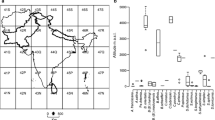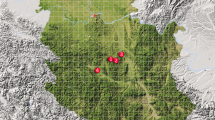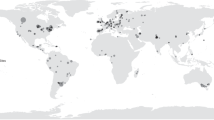Summary
Studies throughout Europe reporting species lists of lumbricid earthworms and ranging from 100 m2 to >500000 km2 are analysed for the regression of species number S on size of area A [km2]. This species-area relation is described by: S=7.9*A 0.09 (r=0.76).
Similar content being viewed by others

References
References in text
Boecklen WJ (1986) Effects of habitat heterogeneity on the species-area relationship of forest birds. J Biogeogr 13:59–68
Bouché MB (1983) The establishment of earthworm communities. In: Satchell JE (ed) Earthworm ecology—from Darwin to vermiculture. Chapman and Hall, London, pp 431–448
Connor EF, McCoy ED (1979) The statistics and biology of the species-area relationship. Am Nat 113:791–833
Connor EF, McCoy ED, Cosby BJ (1983) Model discrimination and expected slope values in species-area studies. Am Nat 122:789–796
Digel W, Kwiatkowski G (eds) (1981) Meyers großes Taschenlexikon. Bibliographisches Institut, Mannheim
Easton EG (1983) A guide to the valid names of Lumbricidae (Oligochaeta). In: Satchell JE (ed) Earthworm ecology — from Darwin to vermiculture. Chapman and Hall, London, pp 475–487
Gilbert FS (1980) The equilibrium theory of island biogeography: fact or fiction? J Biogeogr 7:209–235
Kleinbaum DG, Kupper LL (1978) Applied regression analysis and other multivariable methods. Duxbury Press, North Scituate, (Mass.)
Krebs CJ (1978) Ecology — the experimental analysis of distribution and abundance. 2nd ed, Harper & Row, New York
Lavelle P (1983) The structure of earthworm communities. In: Satchell JE (ed) Earthworm ecology — from Darwin to vermiculture. Chapman and Hall, London, pp 449–466
Lee KE (1985) Earthworms — their ecology and relationships with soils and land use. Academic Press, London
MacArthur RH, Wilson EO (1967) The theory of island biogeography. PUP, Princeton NJ
Preston FW (1962) The canonical distribution of commonness and rarity: part I. Ecology 43:185–215
Reichholf J (1980) Die Arten-Areal-Kurve bei Vögeln in Mitteleuropa. Anz orn Ges Bayern 19:13–26
Simberloff D (1983) Biogeography: the unification and maturation of a science. In: Brush AH, Clark jr GA (eds) Perspectives in ornithology. CUP, Cambridge, pp 411–455
Sokal RR, Rohlf FJ (1981) Biometry. 2nd ed, Freeman, New York
Sugihara G (1981) S=CA z, z≈1/4: a reply to Connor and McCoy. Am Nat 117:790–793
Zicsi A (1982) Verzeichnis der bis 1971 beschriebenen und revidierten Taxa der Familie Lumbricidae. Acta Zool Acad Sci Hung 28:421–454
References in Table 1
Axelsson B, Lohm U, Persson T (1984) Enchyraeids, lumbricids and soil arthropods in a northern deciduous woodland: A quantitative study. Holarct Ecol 7:91–103
Baker GH (1983) Distribution, abundance and species associations of earthworms (Lumbricidae) in a reclaimed peat soil in Ireland. Holarct Ecol 6:74–80
Baltzer R (1956) Die Regenwürmer Westfalens — eine tiergeografische, ökologische und sinnesphysiologische Untersuchung. Zool Jb Syst 84:355–413
Bengtsson SA, Nilsson A, Nordström S, Rundgren S (1975) Habitat selection of lumbricids in Iceland. Oikos 26:253–263
Bösener R (1964) Die Lumbriciden des Tharandter Waldes. Zool Abh Dresden 27:193–263
Bornebusch CH (1928) De Danske regnorme. Flora og Fauna (Aarhus): 65–92
Bouché MB (1972) Lombriciens de France — écologie et systématique. Institut National de la Recherche Agronomique, Paris
Bouché MB (1976) Étude de l'activité des invertebrés epigées prairiaux I. — Resultats generaux et geodrilologiques (Lumbricidae: Oligochaeta). Rev Ecol Biol Sol 13:261–281
Bouché MB (1978) Fonctions des Lombriciens I. Recherches francaises et resultats d'un programme forestier cooperatif (R.C.P. 40). Bull Scientif Bourgogne 30:139–228
Boyd JM (1956) The Lumbricidae in the Hebrides II. Geographical distribution. The Scott Naturalist 68:165–172
Calvin EB, Diaz Cosin DJ (1985) Lombrices de tierra del valle del Tambre (Galicia, España) I. — Relacion con factores del suelo. Rev Ecol Biol Sol 22:341–351
Cuendet G (1984a) A comparative study of the earthworm population of 4 different woodland types in Wytham woods, Oxford [UK]. Pedobiologia 26:421–439
Cuendet G (1984b) Les peuplements lombriciens des pelouses alpines du Mont La Schera (Parc national suisse). Rev Suisse Zool 91:217–228
Cuendet G (1985) Répartition des lombriciens (Oligochaeta) dans la Basse Engadine, le Parc National de le Val Müstair (Grisons, Suisse). Rev Suisse Zool 92:145–163
Drift J van der (1951) Analysis of the animal community in a beech forest floor. Tijdschr Ent 94:1–168
Eggert UJ (1982) Vorkommen und Verbreitung der Regenwürmer (Lumbricidae) des Naturparks “Hoher Vogelsberg”. Beitr Naturkde Osthessens 18:61–103
Ellenberg H, Mayer R, Schauermann J (1986) Ökosystemforschung. Ergebnisse des Sollingprojektes 1966–1986. Ulmer, Stuttgart
Enckell PH, Rundgren S (1983) Terrestrial invertebrates of the Faroe Islands (Denmark): 5. Earthworms (Lumbricidae): Distribution and habitats. Fauna Norv Ser A 4:11–20
Evans AC, Guild WJMcL (1947) Studies on the relationship of earthworms and soil fertility I. Biological studies in the field. Ann Appl Biol 34:307–330
Evans W (1910) The Oligochaeta (Earthworms and their allies) of the Forth area. Proc Roy Phys Soc 18:109–124
Finck A (1952) Ökologische und bodenkundliche Studien über die Leistungen der Regenwürmer für die Bodenfruchtbarkeit. Z Pflanzenernaehr Dueng Bodenk 58:120–145
Füller H (1953) Tiergeographisch-ökologische Untersuchungen über die Lumbriciden des mittleren Saaletales. Wiss Zeitschr Friedr-Schiller-Univers Jena 2:51–60
Füller H (1976) Annelida — Ringelwürmer. In: Stresemann E (ed) Exkursionsfauna für die Gebiete der DDR und der BRD. 5. Aufl, Volk und Wissen, Berlin
Gaspar C, Bouché MB, Laurent G, Wonville C (1981) Recherches sur l'écosystème forêt: les lombriciens des sols forestiers Ardennais. Ann Soc R Zool Belg 111:57–64
Gerard BM (1967) Factors affecting earthworms in pastures. J Anim Ecol 36:235–252
Graff O (1954) Die Regenwurmfauna im östlichen Niedersachsen und in Schleswig-Holstein. Beitr Naturk Niedersachsens 7:48–56
Graff O (1961) Die Regenwürmer (Oligochaeta, Lumbricidae) auf dem Gelände der Froschungsanstalt für Landwirtschaft. Landbauforsch Völkenrode 11:19–22
Graff O (1983) Unsere Regenwürmer. M. & H. Schaper, Hannover
Guild WJMcL (1948) Studies on the relationship of earthworms and soil fertility III. The effect of soil type on the structure of earthworm populations. Ann Appl Biol 35:181–192
Guild WJMcL (1951) The distribution and population density of Lumbricidae (earthworms) in Scottish pasture fields. J Anim Ecol 20:88–97
Haeggström C-A (1985) Octolasion cyaneum and Lumbricus festivus, new record (Oligochaeta, Lumbricidae) found in Aland, southwest Finland. Mem Soc Fauna Flora Fenn 61:131–134
Haeggström C-A, Terhivuo J (1979) The Lumbricidae (Oligochaeta) in the archipelago of Aland, SW Finland. Mem Soc Fauna Flora Fenn 55:17–31
Julin E (1950) De Svenska daggmaskarterna. Ark Zool 42 (17):1–58
Karppinen E, Nurminen M (1964) Records of Lumbricids (Oligochaeta) in Finland. Ann Zool Fenn 1:44–47
Kollmannsperger F (1934) Die Oligochaeten des Bellinchengebietes, eine ökologische, ethologische und tiergeographische Untersuchung. Inaugural-Dissertation, Berlin
Kübelböck G, Meyer E (1981) Ökologische Untersuchungen an Wirbellosen des zentralalpinen Hochgebirges (Obergurgl, Tirol), VI. Abundanz und Biomasse der Oligochaeta (Lumbricidae, Enchytraeidae). Veröffentlichungen der Universität Innsbruck 130, Alpin Biologische Studien XV
Kühle JC (1983) Adaptation of earthworm populations to different soil treatments in apple orchard. Lebrun P (ed), New Trends in Soil Biology, Louvain-la-Neuve, pp 487–501
Kvavadze ESh (1985) The earthworms (Lumbricidae) of the Caucasus (in Russian). Mecniereba, Tiflis
Letschert D (1986) Untersuchungen zur Arthropoden- und Annelidenfauna von Weizen- und Zuckerrübenfeldern in einem konventionellen und einem biologisch-dynamischen Anbau. Z Angew Zool 73:93–114
Martinucci G, Sala G (1979) Lumbricids and soil type in prealpine and alpine woods. Bolletino di zoologia 46:279–297
Meyer E, Schwarzenberger I, Stark G, Wechselberger G (1984) Bestand und jahreszeitliche Dynamik der Bodenmakrofauna in einem inneralpinen Eichenmischwald (Tirol, Österreich). Pedobiologia 27:115–132
Michaelsen W (1890) Die Lumbriciden Mecklenburgs. Arch des Vereins der Freunde der Naturgesch in Mecklenburg 44:48–54
Michalis K (1975) Die Oligochaeten der Insel Kos. Sci Annals Fac Phys & Mathem Univ Thessaloniki 15:187–199
Michalis K (1982) Katalog der Oligochaetenfauna Griechenlands. Biol Gallo-Hell 9:343–362
Michalis K, Fragoulis A, Panidis S (1985) Earthworms (Oligochaeta: Lumbricidae) from the mountainous mass of Pella province: Southwest region, and Imathia province [Greece], Northwest region: A systematical and ecological study. Ecol Medit 11:37–42
Mrsic N (1980) A review of the Oligochaeta and some new species of earthworms (Lumbricidae) of Slovenia. Biol Vestn 28:27–38
Mrsic N (1982) Allolobophora altimontana sp.n. (Oligochaeta, Lumbricidae) — a new earthworm species in Slovenia. Biol Vestn 30:57–62
Mrsic N (1983) Research on fauna and associations of earthworms (Lumbricidae) in Durmitor, Crna Gora (Montenegro). Biol Vestn 31:53–66
Nakamura N (1981) Some observations on occurence of earthworms in forest habitats. Ekol Pol 29:97–116
Nordström S, Rundgren S (1973) Associations of lumbricids in Southern Sweden. Pedobiologia 13:301–326
Nordström S, Rundgren S (1976) Lumbricus polyphemus in the Kaiserstuhl area, Southwestern Germany. Pedobiologia 16:373–378
Nowak E (1971) Productivity investigation of two types of meadows in the Vistula Valley IV. Soil macrofauna. Ekologia Polska 13:129–137
Nowak E (1975) Population density of earthworms and some elements of their production in several grassland environments. Ekologia Polska 23:459–491
Persson T, Lohm U (1977) Energetical significance of the annelids and arthropods in a Swedish grassland soil. Ecol Bull 23:1–211
Phillipson J, Abel R, Steel J, Woodell SRJ (1976) Earthworms and the factors governing their distribution in an English beechwood. Pedobiologia 16:258–285
Piearce TG (1972) Acid intolerant and ubiquitous Lumbricidae in selected habitats in North Wales. J Anim Ecol 41:397–410
Pignet E, Bretscher K (1913) Oligochètes. Catalogue des invertebrés de la Suisse. Fasc 7, Genf
Pizl V (1983a) Helodrilus oculatus, a new record (Oligochaeta, Lumbricidae) for the fauna of Czechoslovakia. Vestn Cesk Spol Zool 47:288–289
Pizl V (1983b) Octolasium montanum, new record (Oligochaeta, Lumbricidae) in Czechoslovakia. Vestn Cesk Spol Zool 47:290–292
Plisko JD (1973) Lumbricidae. Fauna Polski, Warszawa
Reynolds JW (1972) Répartition et Biomasse des Lombricidés (Oligochaeta: Lumbricidae) dans Trois Bois de la France (Département d'Essonne). Megadrilogica 1:1–6
Reynoldson TB (1955) Observations on the earthworms of North Wales. North West Nat 3:291–304
Römbcke J (1985) Zur Biologie eines Buchenwaldbodens 6. Die Regenwürmer. Carolinea 43:93–104
Ronde G (1951) Volkommen, Häufigkeit und Arten von Regenwürmer in verschiedenen Waldböden und unter verschiedenen Bestockungen 1. Forstwiss Centralbl 70:521–552
Ronde G (1953a) Vorkommen, Häufigkeit und Arten von Regenwürmern in verschiedenen Waldböden und unter verschiedenen Bestockungen 2. Forstwiss Centralbl 72:37–56
Ronde G (1953b) Vorkommen, Häufigkeit und Arten von Regenwürmern in verschiedenen Waldböden und unter verschiedenen Bestockungen 3+4. Forstwiss Centralbl 72:286–301
Ronde G (1954) Vorkommen, Häufigkeit und Arten von Regenwürmern in verschiedenen Waldböden und unter verschiedenen Bestockungen 5+6. Forstwiss Centralbl 73:113–126
Rozen A (1982) The annual cycle in populations of earthworms (Lumbricidae, Oligochaeta) in three types of oak-hornbeam of the Niepolomicka Forest I. Species composition, dominance frequency and associations. Pedobiologia 23:199–208
Satchell JE (1980) Earthworm populations of experimental birch plots on a Calluna podzol. Soil Biol Biochem 12:311–316
Schwenke W, Bäumler W, Koschel H, Matschek M, Roomi MW (1970) Über die Verteilung, Biologie und Ökologie von Enchytraeiden, Lumbriciden, Oribatiden und Collembolen im Boden schädlingsexponierter und nicht exponierter Nadelwälder. Anz Schädlingsk Pflanzenschutz 43:33–41
Sims RW, Gerard BM (1985) Earthworms (Synopses of the British Fauna, NS, no 31). E.J. Brill/Dr. W. Backhuys, London
Southern R (1909) Monograph of the British and Irish Oligochaeta. Proc Roy Irish Acad 27:119–182
Standen V (1979) Factors affecting the distribution of Lumbricids (Oligochaeta) in associations of peat and mineral sites in Northern England. Oecologia 42:359–374
Stöp-Bowitz C (1969) A contribution to our knowledge of the systematics and zoogeography of Norwegian earthworms (Anelida Oligochaeta: Lumbricidae). Nytt Mag Zool 17:169–280
Stöp-Bowitz C (1974) Earthworms (Annelida Oligochaeta: Lumbricidae). Fauna of the Hardangervidda (Zoologisk Museum, Universitet i Bergen) 6:37–46
Svendsen JA (1957) The distribution of Lumbricidae in an area of pennine moorland (Moor House Nature Reserve). J Anim Ecol 26:411–421
Terhivuo J (1982) Contributions to the knowledge of Lumbricidae (Oligochaeta) in Finland and northeastern Norway. Mem Soc Fauna Flora Fenn 58:77–80
Timm T (1970) On the fauna of the Estonian Oligochaeta. Pedobiologia 10:52–78
Volz P (1961) Die Regenwürmer der südlichen Vorderpfalz. Mitt Pollichia III.R.8.Bd:199–208
Wendorff A, Brzezinska E (1980) Numbers, biomass and vertical distribution of earthworms of the pastures in regions of Krakow and Jaworki (Poland). Acta Agrar Silvestria Ser Agrar 19:209–216
Wilcke D (1940) Untersuchungen zur Lumbriciden-Fauna Schlesiens. Sitzungsber Ges Naturforsch Freunde zu Berlin Jg 1939:220–230
Wilcke D (1941) Der gegenwärtige Stand unserer Kenntnis der märkischen Lumbriciden-Fauna. Märk Tierw 4:34–50
Witkowski T (1980) Abundance and biomass of earthworms (Lumbricidae) in chosen crop-fields. Pol Ecol Stud 6:293–303
Zajonc I (1981) Dazdovny (Oligochaeta; Lumbricidae) Slovenska. Biologicke Prace 27:3–135
Zicsi A (1959) Faunistisch-systematische und ökologische Studien über die Regenwürmer Ungarns II. Acta Zool Acad Sci Hung 5:401–447
Zicsi A (1965) Beiträge zur Kenntnis der Lumbricidenfauna Österreichs. Opusc Zool Budapest 5:247–265
Zicsi A (1979) Neue Angaben zur Regenwurmfauna der Schweiz (Oligochaeta: Lumbricidae). Rev Suisse Zool 86:473–484
Zicsi A (1981) Weitere Angaben zur Kenntnis der Lumbricidenfauna Italiens (Oligochaeta: Lumbricidae). Opusc Zool Budapest 17/18:157–180
Zicsi A, Csuzdi C (1986) Regenwürmer aus Bulgarien (Oligochaeta: Lumbricidae). Opusc Zool Budapest 22:113–121
Zuck W (1952) Untersuchungen über das Vorkommen und die Biotope einheimischer Lumbriciden. Jahresh Ver Vaterl Naturk Württemb 107:95–132
Author information
Authors and Affiliations
Additional information
Revised version of a poster presented at the Wilhelm Michaelsen Memorial Symposium (International Symposium on Terrestrial Oligochaeta), Hamburg Sept. 14–18th 1987
Rights and permissions
About this article
Cite this article
Judas, M. The species-area relationship of European Lumbricidae (Annelida, Oligochaeta). Oecologia 76, 579–587 (1988). https://doi.org/10.1007/BF00397874
Received:
Issue Date:
DOI: https://doi.org/10.1007/BF00397874



